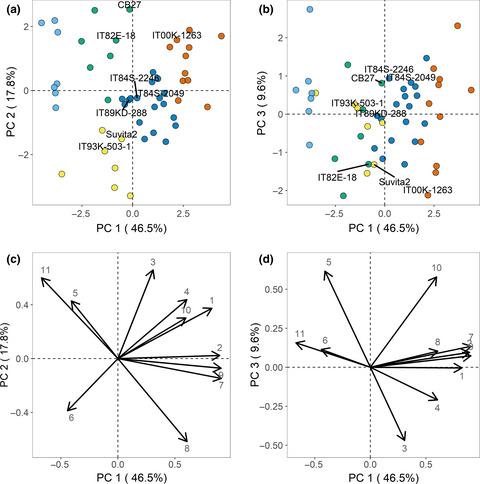当前位置:
X-MOL 学术
›
Food Energy Secur.
›
论文详情
Our official English website, www.x-mol.net, welcomes your feedback! (Note: you will need to create a separate account there.)
Assessing diversity in canopy architecture, photosynthesis, and water‐use efficiency in a cowpea magic population
Food and Energy Security ( IF 5 ) Pub Date : 2020-08-07 , DOI: 10.1002/fes3.236 Anthony Digrado 1, 2, 3 , Noah G. Mitchell 1, 2, 3 , Christopher M. Montes 1, 2, 3 , Paulina Dirvanskyte 4 , Elizabeth A. Ainsworth 1, 2, 3
Food and Energy Security ( IF 5 ) Pub Date : 2020-08-07 , DOI: 10.1002/fes3.236 Anthony Digrado 1, 2, 3 , Noah G. Mitchell 1, 2, 3 , Christopher M. Montes 1, 2, 3 , Paulina Dirvanskyte 4 , Elizabeth A. Ainsworth 1, 2, 3
Affiliation

|
Optimizing crops to improve light absorption and CO2 assimilation throughout the canopy is a proposed strategy to increase yield and meet the needs of a growing population by 2050. Globally, the greatest population increase is expected to occur in Sub‐Saharan Africa where large yield gaps currently persist; therefore, it is crucial to develop high‐yielding crops adapted to this region. In this study, we screened 50 cowpea (Vigna unguiculata (L.) Walp) genotypes from the multi‐parent advanced generation inter‐cross (MAGIC) population for canopy architectural traits, canopy photosynthesis, and water‐use efficiency using a canopy gas exchange chamber in order to improve our understanding of the relationships among those traits. Canopy architecture contributed to 38.6% of the variance observed in canopy photosynthesis. The results suggest that the light environment within the canopy was a limiting factor for canopy CO2 assimilation. Traits favoring greater exposure of leaf area to light such as the width of the canopy relative to the total leaf area were associated with greater canopy photosynthesis, especially in canopies with high biomass. Canopy water‐use efficiency was highly determined by canopy photosynthetic activity and therefore canopy architecture, which indicates that optimizing the canopy will also contribute to improving canopy water‐use efficiency. We discuss different breeding strategies for future programs aimed at the improvement of cowpea yield for the Sub‐Saharan African region. We show that breeding for high biomass will not optimize canopy CO2 assimilation and suggest that selection should include multiple canopy traits to improve light penetration.
中文翻译:

评估cow豆魔术种群的冠层结构,光合作用和水分利用效率的多样性
为提高产量并在2050年之前满足不断增长的人口需求,建议对作物进行优化以改善整个冠层的光吸收和CO 2同化。全球范围内,预计撒哈拉以南非洲的最大人口增长将是最大的,因为撒哈拉以南非洲的单产差距较大目前持续;因此,开发适合该地区的高产作物至关重要。在这项研究中,我们筛选了50个cow豆(Vigna unguiculata(L.)Walp)来自多亲代杂交世代(MAGIC)的基因型,通过冠层气体交换室进行冠层建筑特征,冠层光合作用和水利用效率,以增进我们对各冠层之间关系的理解这些特征。冠层结构占冠层光合作用中观察到的方差的38.6%。结果表明,冠层内部的光照环境是冠层CO 2的限制因素同化。有利于叶面积更多地暴露于光的性状,例如冠层的宽度相对于总叶面积,与冠层的光合作用相关,尤其是在具有高生物量的冠层中。冠层的用水效率在很大程度上取决于冠层的光合作用,因此,冠层的结构也决定了这一点,这表明优化冠层也将有助于提高冠层的水分利用效率。我们讨论了未来计划的不同育种策略,这些计划旨在提高撒哈拉以南非洲地区的cow豆产量。我们表明高生物量的育种不会优化冠层CO 2同化,并建议选择应包括多个冠层性状以提高光的穿透率。
更新日期:2020-08-07
中文翻译:

评估cow豆魔术种群的冠层结构,光合作用和水分利用效率的多样性
为提高产量并在2050年之前满足不断增长的人口需求,建议对作物进行优化以改善整个冠层的光吸收和CO 2同化。全球范围内,预计撒哈拉以南非洲的最大人口增长将是最大的,因为撒哈拉以南非洲的单产差距较大目前持续;因此,开发适合该地区的高产作物至关重要。在这项研究中,我们筛选了50个cow豆(Vigna unguiculata(L.)Walp)来自多亲代杂交世代(MAGIC)的基因型,通过冠层气体交换室进行冠层建筑特征,冠层光合作用和水利用效率,以增进我们对各冠层之间关系的理解这些特征。冠层结构占冠层光合作用中观察到的方差的38.6%。结果表明,冠层内部的光照环境是冠层CO 2的限制因素同化。有利于叶面积更多地暴露于光的性状,例如冠层的宽度相对于总叶面积,与冠层的光合作用相关,尤其是在具有高生物量的冠层中。冠层的用水效率在很大程度上取决于冠层的光合作用,因此,冠层的结构也决定了这一点,这表明优化冠层也将有助于提高冠层的水分利用效率。我们讨论了未来计划的不同育种策略,这些计划旨在提高撒哈拉以南非洲地区的cow豆产量。我们表明高生物量的育种不会优化冠层CO 2同化,并建议选择应包括多个冠层性状以提高光的穿透率。


























 京公网安备 11010802027423号
京公网安备 11010802027423号